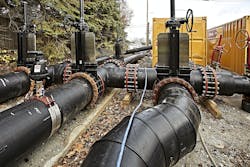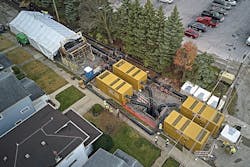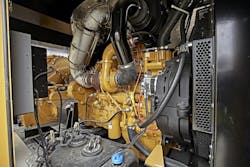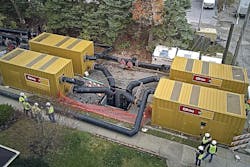Big Bypass, Tight Schedule
About the author:
Melissa Wright is marketing strategist for Franklin Electric. Wright can be reached at [email protected] or 260.210.3516
When a city with almost half a million residents needed to undergo a large-scale infrastructure and sewer rehabilitation project, it knew it would need some major sewer bypass solutions – solutions that were far from “off the shelf.”
Specifically, the city needed to bypass a relief sewer that picked up wastewater, rainwater and snowmelt from three combined sewer overflow outfalls. It needed the solution in place quickly, since time was running out on the timeline set for the project – which was in the final stages of completion in 2020.
While 2020 marked the year the bypass was needed, the project was more than a decade in the making. The city had been struggling with aging sewers that had been built long before indoor plumbing was common in the area. As a result, the city, which is surrounded by three waterways, had been experiencing an average of 71 sanitary sewage overflows a year. In 2008, it reached an agreement with the federal government to fix the situation, thereby lowering or completely eliminating the number of incidences. The project was massive and included more than $12 million invested in the sewage system. Nearly half of that was dedicated to the final phase of the project: the relining of approximately 2,800 linear feet of 84-inch sewer, along with the construction of four new sanitary structures.
To complete this section, the city needed to find pump packages that could seamlessly bypass the normal sewage flowing through the pipes that would be out-of-service while under repair. The city also needed the pumps to handle any “worst case” pumping scenarios, like unseasonal infiltration from weather-related events.
“The project’s scale and complexity required the right solution, one that we could easily transport and service,” said Joe Wagner, pump & shoring manager for Ohio Cat, who worked on sourcing equipment for the job.
Noise Control
In addition to pumping capacity, the pump packages would be operating in a residential area, so noise control was also a concern. The parameters of the project required work be done by a specific deadline, so finding or building the right equipment quickly was also critical.
Ohio Cat reached out to Franklin Electric to determine if their Pioneer Pump brand had a solution that would handle the application requirements, and if product could be delivered within the short time frame.
“We knew from experience that a pump package of this size could potentially take a year or longer to build, and we only had a few months lead time,” Wagner said. “We had used Pioneer Pump packages in the past and thought their experience would be a good match for this size of a project.”
Wagner set specific parameters for the bypass solution and had clear expectations for the solution.
“The expectation was for these pumps to bypass the necessary wastewater and precipitation flows in the best- and worst-case scenarios,” Wagner added. “Additionally, with engines this size, noise was a concern. The units would be used near residential neighborhoods, so we needed to make sure the sound did not disturb the homes located within 10 feet of the packages.”
Faced with tight timing parameters and big pumping needs, Franklin Electric got to work engineering a solution.
“Our 18-inch pump ends in our Pioneer Pump portfolio have been used for over 20 years in the rental industry,” said Chris Nelson, director of U.S. industrial sales for Franklin Electric, who worked closely with Ohio Cat. “Ohio Cat was able to supply the engine, which was a huge time savings and a major benefit of a partnership like this. What becomes a challenge is when you have to package together these very large pump and engine combinations in a way that’s quiet enough to run next to someone’s home, a school or a hospital. That seems to be where these jobs typically take place.”
Final Pump Packages Installed
Pairing the Pioneer Prime 18-inch with Caterpillar C13B engines, Franklin Electric designed and built four custom Sound Attenuated Diesel Pump Packages, each engineered to handle 10,800 gallons per minute. With a sound attenuated enclosure rating of 69 dB(A), the units were also engineered to control the noise generated by the high-horsepower engines.
Two of the pump packages immediately went to work handling the 47 million gallons per day (mgd) of wastewater that regularly flowed through the old sewage pipe under repair. The other two pump packages were on-site as standby units and were designed to provide complete redundancy, featuring the same specs and parameters as the primary pumps.
“Sewage never stops, so redundancy is critical on a job like this. If the primary pumps go down for any reason, the two backup pumps meet the full requirements of the job,” Nelson said.
The combined enclosed pump packages were the largest ones ever built by Franklin Electric, yet the company did not let the project’s size slow down its production schedule: Franklin Electric was able to manufacture and deliver the packages in three months.
“Accommodating Ohio Cat’s configuration quickly came down to having the right pumps in our lineup and having engines available immediately from Caterpillar,” Nelson said. “The nature of our large platforms allows us to make modifications and adjustments to engineer a package of this scale in a timely manner.”
Additional Benefits: Portability & Service
In addition to creating pump packages that met all of the performance parameters, Franklin Electric also engineered the entire solution to deliver portability and easy access, critical to meet the demands of the job site and application. The complete system is housed in a single shipping container and is built on a skid, allowing it to be rolled out for routine maintenance.
“Having the entire unit roll out of the enclosure is a huge benefit to keeping the project running smoothly,” Wagner said. “Without this feature, we’d have to spend an entire day taking the enclosure off before we could even begin to perform a service or repair on the pumps.”
It also allows crews to inspect the equipment regularly.
Ohio Cat invested in the units specifically for this project and plans to add them to its offering of rental equipment for the future.
“These units are unique in what they can handle and since they are built on a skid, we can easily transport them across the country, if needed,” Wagner said.
Ohio Cat anticipates using the pump packages for dewatering ponds and flooding, sewer bypass pumping for utilities maintenance and underground constructions, and emergency bypass for weather-related events.
“This is the type of equipment that becomes essential as more cities improve infrastructure that’s been in place for centuries,” Wagner said. “They do the job in a way that makes everyone’s job easier so progress can happen quickly.”



